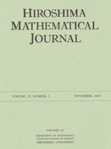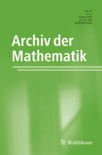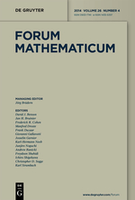
FUNDAMENTA MATHEMATICAE
Scope & Guideline
Elevating mathematical discourse through rigorous research.
Introduction
Aims and Scopes
- Dynamical Systems and Topology:
The journal publishes research on the dynamics of systems, including ergodic theory, Markov processes, and topological dynamics, contributing to a deeper understanding of system behaviors and properties. - Set Theory and Logic:
FUNDAMENTA MATHEMATICAE includes papers on foundational aspects of mathematics, particularly set theory, model theory, and various logical frameworks, which are crucial for establishing the underpinnings of mathematical structures. - Geometric and Algebraic Structures:
Research on geometric properties, algebraic structures, and their interrelations is a key focus, including topics like Coxeter groups, knot theory, and homological algebra, which explore the connections between algebra and geometry. - Measure Theory and Functional Analysis:
The journal addresses topics in measure theory, probability, and functional analysis, emphasizing the study of measures, integration, and functional spaces, providing tools for analyzing complex mathematical phenomena. - Topology and Continuum Theory:
Papers related to topology, including concepts of compactness, connectedness, and continuum theory, are prominent, reflecting the journal's commitment to exploring the intricate properties of topological spaces.
Trending and Emerging
- Ergodic Theory and Dynamical Systems:
There is a noticeable increase in research related to ergodic theory and dynamical systems, reflecting a growing interest in understanding the long-term behavior of complex systems and their statistical properties. - Descriptive Set Theory and Definability:
Emerging themes in descriptive set theory and definability are becoming more prevalent, highlighting the interplay between set theory and topology, and addressing foundational questions about definable sets and functions. - Higher-Dimensional Topology and Algebraic Structures:
Research focusing on higher-dimensional topological spaces and their algebraic counterparts, such as homotopy theory and K-theory, is gaining momentum, showcasing an increased interest in the interactions between topology and algebra. - Measure and Category Theory:
There is a trend towards exploring connections between measure theory and category theory, particularly in the context of definability and structural properties of mathematical objects, reflecting a broader integration of different mathematical disciplines.
Declining or Waning
- Classical Geometry:
Topics directly related to classical geometric constructions and properties have seen a decline, as contemporary research increasingly emphasizes algebraic and topological approaches over traditional geometric methods. - Elementary Number Theory:
Research focusing on basic number-theoretic problems has become less frequent, with a shift towards more abstract and higher-dimensional number theory, reflecting evolving interests within the mathematical community. - Combinatorial Geometry:
The area of combinatorial geometry, while still relevant, has not been a central theme in recent publications, indicating a possible shift towards more analytical and algebraic perspectives in geometric research. - Purely Computational Techniques:
Papers emphasizing purely computational techniques or algorithmic approaches without deeper theoretical insights appear to be less common, suggesting a move towards more theoretical or conceptual advancements in mathematics.
Similar Journals

Mediterranean Journal of Mathematics
Advancing Mathematical Frontiers in the Mediterranean BasinThe Mediterranean Journal of Mathematics, published by SPRINGER BASEL AG, is a prominent platform dedicated to the advancement of mathematical research and education. Since its inception in 2004, this journal has been pivotal in disseminating high-quality research across various fields of mathematics, currently holding a notable Q2 ranking in the miscellaneous mathematics category as of 2023. With its ISSN 1660-5446 and E-ISSN 1660-5454, the journal enjoys a respected position in the academic community, evident by its Scopus rank of 129 out of 399 in General Mathematics, placing it in the 67th percentile. While primarily a subscription-based journal, it remains committed to providing a comprehensive resource for researchers, professionals, and students, fostering dialogue and exploration within the mathematical sciences. The Mediterranean Journal of Mathematics, based in Basel, Switzerland, continues to contribute significantly to the evolution of mathematical theory and practice, marking its relevance as we approach its 20th anniversary in 2024.

BULLETIN OF THE BRAZILIAN MATHEMATICAL SOCIETY
Connecting Ideas, Cultivating Knowledge in MathematicsBulletin of the Brazilian Mathematical Society is a distinguished journal published by Springer Heidelberg, aimed at advancing the field of mathematics through the dissemination of research findings and scholarly discourse. With an ISSN of 1678-7544 and an E-ISSN of 1678-7714, this journal is indexed within the Q2 quartile in the field of mathematics (miscellaneous), reflecting its impact and relevance in the academic community. The journal has been recognized for its commitment to quality, as evidenced by its Scopus ranking within the 58th percentile among general mathematics publications. Since its inception in 1996, the Bulletin has served as a vital platform for mathematicians to share innovative ideas, theoretical advancements, and practical applications, making it essential reading for researchers, professionals, and students alike. Open access options are available, ensuring that the latest research is accessible to a wide audience, thereby fostering collaboration and growth within the mathematics community.

MICHIGAN MATHEMATICAL JOURNAL
Unveiling New Perspectives in Mathematics Since 1996The MICHIGAN MATHEMATICAL JOURNAL is a prestigious and influential publication in the field of mathematics, founded by the University of Michigan. With an ISSN of 0026-2285 and an E-ISSN of 1945-2365, this journal is recognized for its high-quality research and has achieved a commendable Q1 ranking in the category of Mathematics (miscellaneous) as of 2023. Published by the esteemed Michigan Mathematical Journal, it provides a platform for the dissemination of innovative mathematical theories and findings, playing a crucial role in advancing knowledge and scholarship within the mathematical community. With coverage spanning from 1996 to 2024, the journal emphasizes rigorous theoretical development and fosters collaboration among researchers, professionals, and students alike. While not an open-access journal, its contributions are invaluable for those looking to stay abreast of cutting-edge mathematical research.

JOURNAL OF THE EUROPEAN MATHEMATICAL SOCIETY
Elevating Standards in Mathematical ScholarshipThe JOURNAL OF THE EUROPEAN MATHEMATICAL SOCIETY, published by the EUROPEAN MATHEMATICAL SOCIETY (EMS), stands as a premier platform in the field of mathematics, known for its rigorous editorial standards and impactful contributions to both applied and theoretical aspects of the discipline. With a commendable Q1 ranking in both Applied Mathematics and Miscellaneous Mathematics categories, alongside a Scopus rank of 32 out of 399 in General Mathematics, this journal has established itself as a crucial resource for researchers and professionals. Since achieving Open Access status in 2021, it has expanded its reach, making cutting-edge research more accessible to a global audience. With a publication horizon extending from 2002 to 2024 and a dedicated focus on high-quality mathematical scholarship, the journal continues to foster innovation and collaboration within the mathematical community.

Hiroshima Mathematical Journal
Exploring the Depths of Algebra, Analysis, and BeyondThe Hiroshima Mathematical Journal, published by Hiroshima University, Graduate School of Science, serves as a prominent platform for disseminating high-quality research in the field of mathematics. Established in 1959, the journal has been an integral part of the mathematical community, focusing on areas such as Algebra, Number Theory, Analysis, and Geometry and Topology. Although currently classified in Q4 quartile rankings within its categories, the journal is committed to advancing mathematical knowledge and fostering scholarly dialogue. Its accessibility, combined with its long-standing history, makes it an essential resource for researchers, professionals, and students dedicated to exploring and enhancing the mathematical sciences. For those interested in contributing or accessing cutting-edge research, the Hiroshima Mathematical Journal continues to uphold its mission of excellence in mathematical scholarship.

ARCHIV DER MATHEMATIK
Advancing Mathematical Frontiers Since 1948ARCHIV DER MATHEMATIK is a distinguished journal published by SPRINGER BASEL AG, renowned for its contributions to the field of mathematics. Established in 1948 and continuing its legacy through to 2024, the journal provides a platform for innovative research and scholarly articles that push the boundaries of mathematical theory and application. With an ISSN of 0003-889X and an E-ISSN of 1420-8938, it holds a reputable position within the academic community, reflected by its Q2 ranking in the 2023 Mathematics (Miscellaneous) category. Despite not being an open access publication, ARCHIV DER MATHEMATIK remains accessible to a global audience through various databases, ensuring the dissemination of high-quality research. The journal’s commitment to enhancing mathematical discourse makes it an essential resource for researchers, professionals, and students seeking to expand their understanding of this vital discipline.

New York Journal of Mathematics
Advancing mathematical frontiers for a global audience.New York Journal of Mathematics is a prominent open-access journal, published by the ELECTRONIC JOURNALS PROJECT, dedicated to advancing the field of mathematics through the dissemination of groundbreaking research. Since its inception in 1996, the journal has evolved into a valuable resource for researchers, educators, and students, particularly in the realm of general mathematics. As of 2023, it proudly holds a Q2 classification in the Mathematics (miscellaneous) category, reflecting its growing impact and reach within the academic community, despite being ranked at the 31st percentile overall. With its commitment to open access since 2022, the journal ensures that high-quality mathematical research is readily available to a global audience, fostering collaboration and innovation. Researchers interested in contributing to this dynamic field will find the journal a vital platform for sharing their findings and engaging with fellow mathematicians around the world.

Cambridge Journal of Mathematics
Empowering Researchers with Cutting-Edge InsightsCambridge Journal of Mathematics, published by INT PRESS BOSTON, INC, is a premier platform for the dissemination of cutting-edge research in the field of mathematics. With an ISSN of 2168-0930 and E-ISSN 2168-0949, this journal stands out in a competitive academic landscape, currently ranked #58 out of 399 in General Mathematics, placing it in the top 15% within its category according to Scopus metrics. The journal serves as a vital resource for researchers, professionals, and students alike, aiming to foster groundbreaking mathematical inquiries and foster collaboration across disciplines. Published from 2020 to 2024, the Cambridge Journal of Mathematics is committed to maintaining high standards of scholarship, making it an essential read for those who are passionate about advancing mathematical knowledge and its applications.

FORUM MATHEMATICUM
Pioneering Research in Applied and Theoretical MathematicsFORUM MATHEMATICUM, published by WALTER DE GRUYTER GMBH, is a distinguished academic journal based in Germany, known for its significant contributions to the field of mathematics. With an ISSN of 0933-7741 and an E-ISSN of 1435-5337, the journal features comprehensive studies ranging from applied mathematics to diverse mathematical disciplines. Having maintained a commendable presence since 1989, FORUM MATHEMATICUM has achieved notable classification rankings, including Q2 in Applied Mathematics and Q1 in miscellaneous Mathematics as of 2023. Additionally, it holds a Scopus rank within the top 60th percentile in General Mathematics, making it a prominent platform for researchers and professionals seeking rigorous analysis and innovative methodologies in mathematics. While the journal does not currently offer open access, its rich content is pivotal for advancing mathematical theory and applications, appealing to students and seasoned academics alike.

Selecta Mathematica-New Series
Exploring the Depths of Mathematical and Physical Theories.Selecta Mathematica-New Series is a premier academic journal published by Springer International Publishing AG, based in Switzerland. With an impressive impact in the fields of Mathematics and Physics, it is recognized in the Q1 category for both Mathematics (Miscellaneous) and Physics and Astronomy (Miscellaneous) as of 2023. Established in 1995, the journal provides a platform for rigorous peer-reviewed research, facilitating the dissemination of groundbreaking findings and theoretical advancements through its converged publication years up to 2024. Researchers and scholars seeking to stay at the forefront of mathematical and physical sciences will benefit from the journal's diverse scope and high-impact articles. Although it does not operate under an open-access model, Selecta Mathematica-New Series remains a vital resource for building knowledge and fostering collaboration among professionals and students engaged in these dynamic fields. Access to its content is essential for those aiming to deepen their understanding and contribute to the ongoing dialogue within the scientific community.